![]()
Part 1 -- Denver to Hannibal, December 20 to December 30
Part 2 -- Hannibal to Memphis, December 31 to January 3
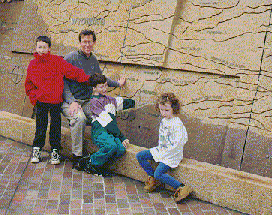
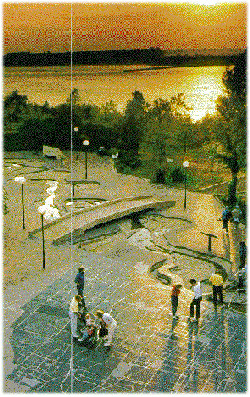 Memphis
has a great, 4-block long model of the lower Mississippi River. It's called
the "Riverwalk," and it's part of the Mississippi River Museum. For River buff,
as we are becoming, this thing is truly astounding.
Memphis
has a great, 4-block long model of the lower Mississippi River. It's called
the "Riverwalk," and it's part of the Mississippi River Museum. For River buff,
as we are becoming, this thing is truly astounding.
The lower Mississippi, "Old Man River," is modeled in great detail -- one mile to 30 inches. We can pick out Graceland on the map of Memphis and Fort Defiance in Cairo. To show the most complicated upper drainages, like the Missouri's, there are horizontal maps with all of the tributaries carved in the cement. This lets us track a path all the way from Denver's Confluence Park -- where Cherry Creek meets the South Platte River -- to the Mississippi and all the way to the Gulf of Mexico.
In the summer, when the Museum is actually open, water flows down the tributaries, through the model, and eventually empties into a one-acre "Gulf of Mexico." According to the Mud Island website, the Gulf doubles as "Tennessee's largest chlorinated swimming pool with 1.3 million gallons of water and a 20,000 square foot white sand beach."
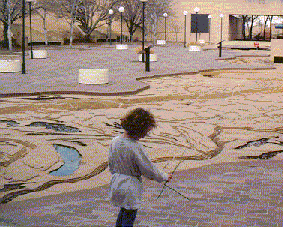 We guess the Mississippi River Museum would also be pretty good. Anyone who would think up the Riverwalk would probably do a pretty good job on a museum. Unfortunately the Museum and the Riverwalk are closed. Fortunately, the Riverwalk is outside, and the security guard didn't nab us until Duncan and Tote had made it to the Gulf.
We guess the Mississippi River Museum would also be pretty good. Anyone who would think up the Riverwalk would probably do a pretty good job on a museum. Unfortunately the Museum and the Riverwalk are closed. Fortunately, the Riverwalk is outside, and the security guard didn't nab us until Duncan and Tote had made it to the Gulf.
We had a picnic lunch in Confederate Park, overlooking Mud Island and the River. It has a pleasant view but a rather scabrous clientele and rundown feel. A statue of Jefferson Davis, "a patriot," stands in a prominent place. Demonstrating how close to the mainstream the Confederacy remains, the flowers around Davis's feet sport a sign announcing they are provided by Northwest Airlines.
Just down the street from Confederate Park is the new City Market. Around it are all sorts of rehabbed warehouse buildings, now doing duty as condos and apartments. This part of Memphis seems to be booming. (The City Market has a great slogan -- "See ya tomorrow!"
The National Civil Rights Museum is
One interesting thing the Museum reveals about the Civil Rights movement is the intense competition between groups on the same side. Environmental funders routinely criticize environmental groups for not coordinating better or pulling in different directions. One thing the Museum reveals is that this diversity, and often outright competition, is not fatal and is probably beneficial.
The museum is arranged in strict chronological
City Market
Vicksburg looks as if it is the most prosperous River city we have yet seen. Most of the cities we have seen, from Davenport on downstream, look like they have seen better days. Many show signs of restoration efforts, but these reveal the decay of the River economies more than demonstrating any renewed vitality.
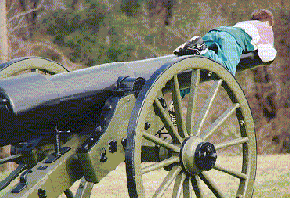 We visited the National Military Park at the Vicksburg battlefield. This is the first Civil War battlefield any of us have seen. The most striking thing about the place, unfortunately, is that the ground is nearly covered with memorials. Individual states have put up markers to identify where their troops bivouacked, fought, and dug trenches. There are memorials to individual officers, and giant obelisks and temples to entire states. The Park Service has also marked most units with signs, significant events with signs, and even trenches with more signs. Although the markers give some idea of just how many men fought at Vicksburg, they also give the battlefield a strangely sterile air -- perhaps because there is little room for imagination.
We visited the National Military Park at the Vicksburg battlefield. This is the first Civil War battlefield any of us have seen. The most striking thing about the place, unfortunately, is that the ground is nearly covered with memorials. Individual states have put up markers to identify where their troops bivouacked, fought, and dug trenches. There are memorials to individual officers, and giant obelisks and temples to entire states. The Park Service has also marked most units with signs, significant events with signs, and even trenches with more signs. Although the markers give some idea of just how many men fought at Vicksburg, they also give the battlefield a strangely sterile air -- perhaps because there is little room for imagination.
Vicksburg was, in the main, a siege. The Confederates fortified Vicksburg in an effort to maintain control of the Mississippi River -- more accurately, holding Vicksburg would have let the Confederates prevent the Union from using the Mississippi. By the time of the battle of Vicksburg, the Union controlled most of the Mississippi.
The siege lasted about a month. Some of Vicksburg's citizens hid in caves dug into the clay beneath the city. Some of Vicksburg's mansions were transformed to Army headquarters or hospitals. News that one house that had been converted to a hospital treated Confederate wounded in the basement to protect them from shelling -- but placed the Union wounded on roof -- shocked the children. The Vicksburg Courthouse is still standing, because the Confederates used it to house Union prisoners.
The Union never penetrated Vicksburg's defenses, but it was on the verge of doing so. Grant, the Union's general, chased the Confederates into Vicksburg and then immediately attacked. Grant thought that the Confederates had been demoralized by being repeatedly forced to retreat. Whatever the Confederates were thinking, the Union failed to take Vicksburg with two direct attacks and so settled into a siege. The Union dug trenches, until Union forces were literally within 8 feet of Confederate lines. It looked as if Vicksburg's defeat was inevitable. Pemberton, the Confederate general, surrendered the city on July 4, 1863.
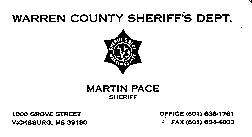
We ate lunch at a great spot, the Walnut Hill Restaurant and ran across Martin Pace -- a trim, sandy-haired fellow. He was cheery, outgoing, and had an easy laugh. Mr. Pace looked more like a good 8th grade science teacher than what he actually is -- a southern Mississippi sheriff. Martin is the Warren County sheriff. He looks like someone who would be more at ease with in a pair of Nikes than in a pair of mirrored sunglasses. He cheerfully answered all of my stupid questions without a single "y'all" slipping into the conversation.
Martin says that if he doesn't look like our stereotype of a southern sheriff, it is in part, because Vicksburg is different than most other Southern cities. The Corps of Engineers has a huge facility in town, and there is a nuclear plant north of Vicksburg. According to Martin, the result is a diverse city with one of the highest concentrations of Ph.D.s in the country.
The diversity and educational level do not automatically translate into universal wealth. As we wound around Vicksburg to look at the beautiful antebellum mansions, we noticed that many of these grand old mansions were located amidst hovels. (Top)
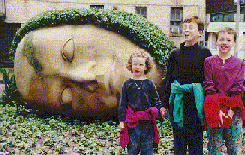
 We spent the day in the French Quarter. Monica pushed us into the Café du Monde, where we sat outside, drank coffee, and munched beignet -- a French cousin of the doughnut. Shortly after we sat down, the kids made a beeline for a juggling clown that had wandered up. When they returned, they were decked from head to toe in balloons. Duncan sported a four-color jester's hat; Tote, a yellow helmet; and Maggie, a giant heart. They all had assorted swords, scabbards, dogs, a swan, and necklaces. The clown would not accept a donation offered by Duncan, but he did pick up some money from other tourists snapping pictures of the clown twisting balloons and sword fighting with the kids.
We spent the day in the French Quarter. Monica pushed us into the Café du Monde, where we sat outside, drank coffee, and munched beignet -- a French cousin of the doughnut. Shortly after we sat down, the kids made a beeline for a juggling clown that had wandered up. When they returned, they were decked from head to toe in balloons. Duncan sported a four-color jester's hat; Tote, a yellow helmet; and Maggie, a giant heart. They all had assorted swords, scabbards, dogs, a swan, and necklaces. The clown would not accept a donation offered by Duncan, but he did pick up some money from other tourists snapping pictures of the clown twisting balloons and sword fighting with the kids.

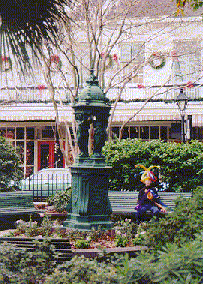
For the rest of the day we wandered around the Quarter, checked out the buildings, and picnicked in the parks. The kids ate nothing nutritious: beignet, ice cream, and pralines. Maggie pointed out balconies and sadly set her balloon swan free in a fountain. Monica shooed the kids past several . . . exotic . . . places on Bourbon Street. Duncan and Tote shopped in the market. (Top)
The Battle of New Orleans
Fish place in Belle Chase
After lunch, we continue toward the River's mouth.
The world's longest bridge


Equine stuff
Marshall Texas - City park
Home of Irene made famous by Ledbetter.
Kansas trails
Maggie ends trip same way we started
Passed the largest prairie dog - 8,000 pounds
Golden Compass